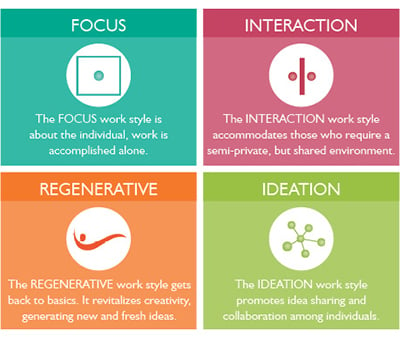What's Your Work Style?

For the majority of us, the days of sitting at our desks from 9-5 are long gone. Checking email at 6 am when rolling out of bed is not uncommon, working on a presentation from an airport lounge is the norm. With the advent of mobile technology, wi-fi, the cloud and a plethora of other tech resources, the ways in which we work have greatly evolved. These tools have also had a tremendous impact on interactions in the workplace.
While we now have the ability to practically work any time or anywhere, there is still a need for dedicated employee workspaces. We still require environments to work independently, to gather, to collaborate and to exchange ideas. Recognizing these changes, KI has identified 4 common work styles that can assist workers and employers in identifying what environments are needed to make employees as productive and engaged as possible. So I ask you, what’s your work style?
Identifying Employee Work Styles
FOCUS – The FOCUS work style is about the individual. Work is accomplished alone, requiring minimal input from others. Employees may need spaces that are more private, blocking out noise and distractions in order to concentrate.
INTERACTION – The INTERACTION work style accommodates those who require a semi-private, but shared environment. While most work is individual in nature, this style requires defined space that spurs conversation among coworkers. Employees want control of their individual space but want the option of freely interacting with others.
REGENERATIVE – The REGENERATIVE work style gets back to basics. It revitalizes creativity, facilitates sharing and generates new and fresh ideas. Employees may be doing something out of the norm like working outdoors or utilizing third spaces.
IDEATION – The IDEATION work style promotes idea sharing and collaboration. Whether brainstorming or educating, this work style brings ideas and people together. Employees require easy access to their coworkers and a free flow of information.

Work styles may vary based on industry, profession, etc. but each represents a basic need for workers. While some may prescribe to one particular style, others may utilize a variety. The goal is simple, identify the work styles of your organization, take those findings and ensure the design of your workplace accommodates the evolving needs of employees.
For more detailed information on each work style, click here.
Subscribe
Stay up to date with the latest trends and more.
